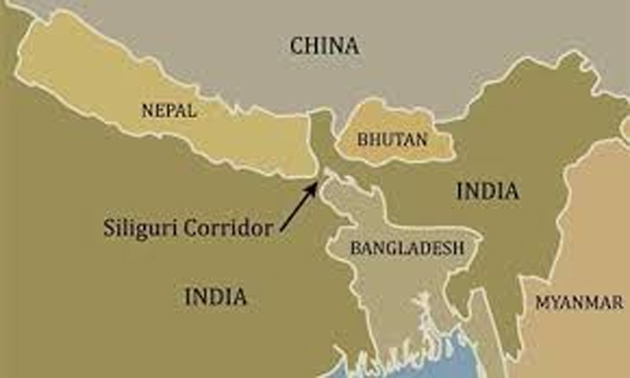‘Securing the corridor -securing the nation’-anonymous

By Colonel Satish Singh Lalotra
Long standing Geo-political compulsions cum differences between nation states often spring up such cartographic adjustments that have repercussions on neighbouring nations often surpassing the logic of such adjustments. In India’s context the narrow sliver of land measuring 22 kms at its narrowest section known by the moniker ‘Siliguri corridor’ is a visible manifestation of country’s partition legacy that was further compounded by the liberation war of 1971. It is no brainer that this very corridor leads to a major chunk of the sub-continent i.e the NE ( North East ) of India as also a gateway to our policy of ‘Look East’ which off late has gained a huge traction under the present Modi dispensation. The dagger like projection jutting inside the Indian side from the north known by the name of ‘Chumbi valley’ of Tibetan autonomous region ( TAR) , the Bhutanese/ Nepalese side of their territory and the northern most district of Bangladesh that touches this corridor is Panchagar with Lalmonirhat and Nilphamari too bordering this sliver of Indian land. The speed with which this sliver of land slips under a fighter jet taking off from Bagdogra air base and getting into any of these neighbouring countries is a mere single digit in terms of minutes ( time). That goes to prove the all too importance of this narrow stretch of land which connects mainland India to its NE portion manifestly in physical as well as emotional terms.As if this was not enough,with political instabilities a by word for NE Of India dating back to pre-independence days, the sheer lateral distance of this part of the country from its governing hub ( New Delhi) breeding an emotional and physical disconnect among its inhabitants; plus the latest turmoil in Bangladesh that has been raging for more than a year sowing seeds of trouble for this corridor of land ( Siliguri), the region never had such a heady ‘cocktail of destruction’. With our northern neighbour China having an age old propensity for fishing in troubled waters ( Collusion with Bangladesh), does it require a ‘Chanayka’ to proffer his advice to the mandarins of power sitting in Raisina hills as to the importance of this corridor in securing our NE and eventually India?
THE COLLUSION
An already restive Bangladesh sitting on the powder keg of religious sectarianism cum strife for the last one year ,and its latest overtures to China for potential investments have raised justifiable concerns in India about the security of the strategically vital ‘Siliguri corridor’. It may well do good to remind the readers of this article , that China has long held the ‘numero-uno’ position in the Asia -pacific ‘ region for filling the vacuum left by the colonial powers over the smaller Asian countries viz Laos, Cambodia, Vietnam, Philippines, the Korean peninsula and the like immediately after the end of the 2 WW. With Bangladesh tottering over its own weight of misdeeds, China is just waiting in the wings to give flight to its fancy of cornering India from the precincts of that so called secular nation (though Islamic in all its way and hue). In fact India is already scrutinizing reports of China’s plan to build an airfield in Bangladesh’s Lalmonirhat district , which falls diametrically opposite to Siliguri corridor and has the shortest flight route for any aircraft taking off from there to intrude into India giving the barest minimum possible reaction time for Indian planners to take on the threat as and when it manifests. It would do well for us to know that in the mid as well as late 1950s the airfield of ‘Kurmitola’ then a Pakistani air base near Dacca was widely used by the CIA/USAF regularly for air drop of supplies, arms and ammunition in Tibet right under the nose of PLA of China in direct support of Tibetan fighters for the cause of Tibetan independence. Can that Bangladeshi propensity of playing into the hands of forces inimical to Indian interests be wished away? It can be, only at our own peril.
Reverting to the present times, the above mentioned proposed airfield of ‘Lalmonirhat’ might have figured during Bangladesh interim regime’s chief adviser MdYunus visit to China recently, though no such reference are found in the international press or media for obvious reasons. ‘Lalmonirhat’ is strategically located in the northwestern Bangladesh, closer to Jalpaiguri and Coochbehar districts of WB. This chicken’s neck is geographically closer to the area. While no Chinese fighter jets have been positioned in India’s eastern neighbourhood so far, any such proposal has serious security implications for India as the entire NE,Sikkim, and WB will come under the radius of action of these fighter jets. During his 4 day visit to China from 26-29th March 2025 the chief adviser had remarked that with NE of India being land locked, Dhaka was the ‘Only guardian of the ocean for all this region’. As if to let know MdYunus who exceeded his remit in his Geo-political utterances, India has terminated the transshipment facility for Bangladesh’s trade. This step could potentially disrupt Bangladesh’s trade with the countries according to a notification issued by the ‘Central board of indirect taxes and customs( CBIC). With prime minister Modi already having shared the dais with the chief advisor MdYunus at the just concluded BIMSTEC( Bay of Bengal multi-sectoral technical and economic cooperation ) summit dinner hosted by the Thailand prime minister , and also met the Bangladesh leader on a one on one basis it has been given to understand that India’s concerns regarding the plight of Hindu minorities in that country had been the center of talks as such. As far as the strategic importance of chicken’s neck is concerned though all are aware of the facts but the latest was the Doklam crisis in 2017 , when China in a repeat performance of its earlier ‘salami slicing’tactics wanted to push southwards and occupy the ‘Jampheri ridge’ of Bhutan thus directly overlooking the area of ‘Siliguri corridor’.
THE LOCAL RED HERRINGS.
Notwithstanding the above, there are certain intangibles which are imperatives to the complexities obtaining in the ‘Siliguri corridor’ area and have the potential of giving an impetus to an already deteriorating security scenario for India. Foremost among them is the milling of a multitude of nationalities to include the illegal Bangladeshi migrants, Rohingyas uprooted from neighbouring Myanmar, the Tibetan refugees living in the general area since 1950s, Chinese immigrants having made India as their second home, Gurkhas of both Nepali as well as Indian descent etc. This makes the region a cauldron of diverse opinions, loyalties (often suspect), as well as a groundswell of support from both the underground workers as well as OGWs affiliated to dubious organizations inimical to Indian interests. With the security situation having gone for a toss in Bangladesh, is it any wonder that some of the renegade elements of the above mentioned communities come together and bind with the Muslim hardliners of Bangladesh thus making this sliver of land a perpetual headache for India from the security point of view?
STRENGHTENING THE CHICKEN’S NECK
The Indian army has described the ‘Siliguri corridor’ as an impregnable fortress countering any potential threats through advanced military preparations. The ‘Trishakti corps’ along with ‘Brahmastra corps’ headquartered at Sukna near the ‘Siliguri corridor’ and Panagarh respectively are the lynch pins around which hinges the entire security of the region. Theformer often called as the ‘Watershed corps’ too is singularly focused on the safeguarding of Indian frontiers all along this area. Working on the principle that govern international boundaries separated by mountains which follow the tenets of ‘ boundary along the peaks’ , the Chinese intentions have always been circumspect when it comes to respecting these tenets. Hence the friction between the two Asian giants.This corps is equipped with the state of the art weaponry, including the Rafale fighter jets, BrahMos missiles, and now the S-400 Triumf long range air defence system. The positioning of S-400 system renowned for its ability to simultaneously track and engage myriad targets at ranges exceeding 400 kms is viewed as a calibrated response to the intensifying aerial activity by both China & Bangladesh near India’s eastern border. The deployment comes following reports of increased military activity by Bangladesh under the interim dispensation, which India considers as an Illegal one. Adding to the already frayed tempers between India & Bangladesh, the latter has recently operationalized Turkish procured ‘Bayraktar TB 2’ unmanned aerial vehicles (UAVs) near the WB & Meghalaya borders perilously close to theChicken’s neck. It has been learnt that Bangladesh’s 67 th Army has deployed these ‘medium -altitude, long endurance'(MALE) drones for enhanced surveillance and recce missions. The ‘Bayraktar TB2’ known for its combat -proven capabilities in conflicts like the ‘Nagorno-Karabakh’, can carry long range laser guided munitions and boasts of a 24 hour flight endurance with an operational range of 300 kms . With the combination of these Turkish UAVs and the proposed building of ‘Lalmonirhat’ air base by the Chinese near the Siliguri corridor the stakes were never so high for India when seen in the light of the fact that China has increased its HALE ( High altitude long endurance) UAV flights near the ‘watershed border’ from the north too for recce missions. Parallel to the above developments, India doctrinal response to both China & Bangladesh hobnobbing has been military assertiveness in the ‘Brahmastra corps’ -India’s first mountain strike corps designated as XVII corps and headquartered at Panagarh , WB. With 2 infantry divisions, independent armoured brigades, and specialized air defence as well as helicopter aviation units under its command , this mountain strike corps along with the Trishakti corps forms a critical pillar of India’s critical deterrence architecture in the currently fast evolving situation in the eastern theatre.
THE WAY FORWARD
For decades to no end, ‘Siliguri corridor’ has represented the proverbial India’s jugular in national defence matrix ,with military planners warning from time to time that a well-executed pincer from the north( China) and south ( Bangladesh) could sever the NE from mainland in no time. This entails the following to be enjoined by us-
* Prioritize rapid response, multi domain deterrence and sustained forward deployment in and around the corridor.
* Set in motion a combo of discernable diplomatic cum military initiatives both north & south of the corridor to subdue the Sino-Bangla collusion.
* Leverage India’s economic cum geographical positioning to realign Bangladesh’s tilt towards India.
* As a countervailing action start immediate deportation of Bangladeshi/ Rohingyas from India, as has been done by Pakistan with relation to Afghans to their native countries as a mark of reversal of our policy of ‘Non-refoulement’ -a core principle of international law that prohibits a country from returning a person to a place where they face a genuine risk of persecution or other serious human rights violations.
* Use ‘Teesta river water treaty’ over the exploitation of Trans- border sharing of waters between India & Bangladesh to tighten screws over the latter.
Measures could be many to rein in the skewed sense of Bangladesh’s relations with regard to India, but it would do well for the policy planners of our country to sit back and take stock of our relations with all our neighbouring countries with whom we don’t enjoy a comfortable rapport; given the size, population and economic might at our command. This under punching of our might will do no good unless the ‘kid gloves’ with which we have been treating them are replaced with actual ‘Boxing gloves’ , so as to let them know the feel and tinge of pain when a threshold of ages of bonhomie is breached on the anvil of expediencies of regional hegemony.
(The writer is a retired army officer.)




